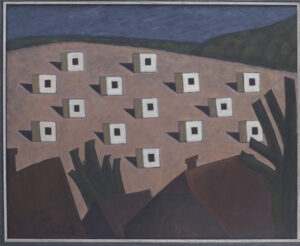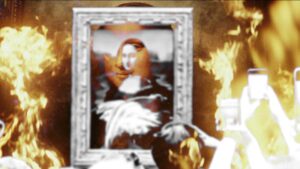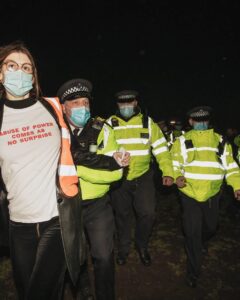The concerted politicization of art in the past decade transcends radical themes in artists’ and curators’ work and the relationship between museums and art workers. It even goes beyond the professionalized paradigm of “social practice art” grounded in liberal ideals of civic dialogue. [1] Art’s recent politicization involves a comprehensive questioning of art institutions’ legitimacy by their publics. Artists practicing new kinds of activist art respond to contemporary art’s diminished moral and political soundness owing to its overly intimate liaisons with the art market. They target museums, galleries, fairs, festivals, magazines, schools, and public cultural agencies with protestations concerning the ways they operate, the officials who govern them, the patrons who underwrite them, and the donors and sponsors who sustain them as government funding becomes harder to secure. They subject art institutions to public scrutiny, highlighting their complicity in perpetuating, concealing, or neglecting unjust and oppressive practices. [2] In the United States alone, “creative direct actions” by groups such as Working Artists for the Greater Economy (W.A.G.E.), Decolonize This Place, Occupy Museums, Not An Alternative, Chinatown Art Brigade, and Gulf Labor Artist Coalition have included petitions, pickets, strikes, boycotts, divestment campaigns, and occupations. [3] In this respect, the art activists’ strategies recall earlier demands by Tucamán Arde, Art Workers Coalition, Women’s Workshop of the Artists’ Union, Black Emergency Cultural Coalition, L’Atelier Populaire, the Guerrilla Girls, and others that administrators grant artists more significant roles in the governance of art institutions. But today’s art activists have shifted the critical focus from the relationship between art institutions and their workers towards sponsors and institutions. They seek to hold the institutions’ administrators accountable to their own avowed stated commitments to cultural education, civic engagement, public discussion, aesthetic enrichment, and moral leadership and behavior beyond the market’s dictates. They have collectivized their power into movements and threats that the institutions cannot afford to ignore. [4]
Contemporary art activists call on their peers to embrace new strategies for a new era. They are “engaged in a simultaneous negation and affirmation of art,” a “dynamic articulation of art and direct action,” a visualization of power structures, and a resocialization of the commons in the face of post-Fordist cognitive capitalism’s efforts to restructure it. [5] Many have left the “feudal system of art (with its institutional chateaux, its exploitation of subjectivities, its embedded critics)” and associated themselves instead with local grassroots organizations. [6] Others, echoing their late-twentieth-century institutional critique predecessors, juxtapose the field of art’s normative self-understanding with the material actuality of the social relations that currently form or articulate it. But today’s art activists are more pragmatic than melancholic or deconstructive. Instead of seeking to restore a foundational set of castaway social democratic values or to visualize the systemized set of presentational techniques, elements, and procedures in operation, they shift the focus of grievance from attempts to regain the art field’s lost promise and understand the logic of its exhibition apparatus’s authority and subject-producing mechanisms to align it with counter-publics in the face of intensifying social and political emergencies. [7] These counter-publics reconstitute social relations not by exposing and critiquing contemporary art’s underlying systems of power and presentation but by forming movements to contravene them. They transmit truth claims, radical pedagogies, militant research, and non-orthodox types of knowledge production, such as how human agents can resist and counter epistemic injustice. In this respect, art activists veer beyond the realm of practice deemed appropriate by the contemporary art’s established institutions, and their work becomes indistinguishable from radical politics.
Contemporary art activists align with art groups worldwide to treat their work’s aesthetic component as inseparable from its social aims and refuse to differentiate between their art and politics. [8] They step from critique to strategy, confronting art institutions without relying on them. They flirt with dissolving the category of art altogether into an expanded field of collective social engagement and creativity, leading to counter-cartographies and new subjective and affective assemblages against undemocratic forms of control. [9] The “collective creativity” liberates sensory and imaginative aspects of art “from their intuitional enclosure to participate in the construction of new forms of life-in-common.” [10] It generates aesthetic manifestations of “infrastructural critique” that are inseparable from political aims. [11] Whether it be the production of posters, flyers, masks, puppets, light projections, protest signs or banners, a museum occupation that presents itself as a site specific happening, or the performance of a strike action in which artists take on an organizing function in creating a collective assemblage of authorship, audience, and distribution networks embedded in political struggle, artists inflect the new art activism with aesthetic concerns. Infrastructure for them signals a view of contemporary art’s institutions as sites of “material, social, and cultural resources” that artists can redirect “in solidarity with broader social movements.” [12]

Tactically, contemporary art activists mobilize the conditions under which the art field steers its officials’ agendas. They target areas of the field such as museums and galleries where reputation is key, antagonizing their officials and creating publicity crises and unanticipated predicaments for their governance and operation. They appropriate the distinct logic of contemporary art institutions’ public and private stature. When art collectives like Global Ultra Luxury Faction (G.U.L.F.), Staub zu Glitzer, or MOMA Divest occupy and shut down museums or art spaces, the institutions’ authorities justify their decisions to clear these sites as soon as possible as administrative and economic imperatives. [13] They need to reopen the museums, suppress the occupations’ participants and content, and regain the territories to show trustees and sponsors that they are in control. The efforts aim to keep nervous patrons confident that their investments in prestige are safe and dissuade them from turning their backs on the institutions. But repeated instances of protest, and the sheer number of artists involved, puts the effectiveness of these efforts to calm patrons in question.
While taking aim at specific policies and practices of museums, information platforms, educational sites, and the like, the activism campaigns seek to hold all of the art infrastructure’s sectors into account. They recognize that since the public expects cultural institutions to maintain some appearance of social responsibility, trustees and sponsors pay as much attention to the institutions’ symbolic value as to their operating fundamentals. As much as well-reviewed shows and programs and balanced operating budgets, the reception of leadership behavior drives the status and worthiness of institutions and the likeliness of their receiving available public funds and significant private “gifts.” Skepticism about this behavior and unfavorable public media attention can be enough to affect the confidence of patrons in an institution’s administration and in the returns their investments in reputation might yield.
Take museums again. More than ever, their authorities must manage their institutions’ attractiveness for funding agencies and private sponsors. Creating symbolic value is their true mandate. The officials must present their museums and programs as projects worthy of speculation by those searching for status in relation to others in the sociocultural context. As such, the fate of museums largely depends on whether their administrators earn the trust of donors and sponsors by building the museums’ reputations. Contemporary art activists appropriate museums’ need to build sponsor and trustee confidence as a tool. They highlight the contradictions between the reputations museum directors seek to build and the museums’ associations and affiliations, and emphasize the value-creating potential of responsible practices. Disinvestment and anti-artwashing campaigns such as Liberate Tate’s drive to end oil giant British Petroleum’s (BP) sponsorship of London’s premier modern art museum, Decolonize This Place’s effort to persuade New York’s Whitney Museum of American Art to expel a weapons-manufacturer trustee from its board, and Prescription Addiction Intervention Now’s (P.A.I.N.) extensive performances compelling the Metropolitan Museum of Art and the Solomon R. Guggenheim Museum to stop accepting gifts from toxic philanthropists who have earned their wealth producing addictive opioids, provide examples of how socially engaged artists can effect change. [14] More than seeking to influence the sentiments of publics that might frequent these museums, the art activists target the speculations of trustees and sponsors who seek dividends of cultural capital, civic glory, and good public relations. As museum authorities rely more on these figures, they become increasingly more anxious about reassuring them than about keeping their commitments to their publics.
Such tactics recognize that like firms, states, and people in our social media-saturated societies, cultural institutions, too, depend more and more on their symbolic value for their patronage. This dependence has altered how artists can resist the institutions. The relentless focus on the museum, publication platform, or educational site’s image and attractiveness in the eyes of potential users and sponsors, and the fact that the behaviors of art institutions and the events affecting them (in any existential register) are liable to cause them to either appreciate or depreciate in standing, open the possibility to pressure institutions into changing through public protests. [15]
More than raising public consciousness, the primary aim of these schemes is to make directors and trustees of museums–as much as the administrators of art schools and owners of galleries and publication firms–worry about the impact their institutions’ questionable acts and associates might have on the overall value of their reputations and assets. Like collectives such as Strike Debt that mobilize enough debtors to give serious weight to the threat of a massive default, artists whose work calls for “collective disruption” of art institutions conjure up the specter of severe instability and put pressure on the institutions’ administrators. [16] They know that good standing can translate into buzz, prestige, and various forms of material support for the institutions. In like manner, notorious donors or socially and environmentally irresponsible behavior can lead to a terrible reputation and hence lack of confidence in the eyes of public users and private patrons alike.
A key strategy of today’s art activists who seek to reform the policy and governance of art institutions is to assess the moral and social value of the institutions’ practices, exhibitions, collections, public missions, workplace environments, board membership, and leadership. They know that, by definition, only others can grant symbolic value. It is social–a function of an institution’s relationship with its constituents. They also know that donors and sponsors of institutions are in pursuit of high regard, which the institution’s standing in the community determines. In calling for pickets, boycotts, strikes, and occupations of problematic cultural entities, contemporary art activists get directly involved in determining reputation. Like the most significant social movements of our times, from Black Lives Matter and #MeToo to migrant rights and climate justice campaigns, the art activists focus on institutions’ traits and conduct and seek to change the terms of the debate by way of realizing their own evaluations. Rather than leaving it to the relationship between art institutions and their sponsors to determine who deserves to be appreciated and for what projects, contemporary art activists judge the targeted institutions for themselves and publicly manifest their verdicts. Their objective is to decenter institutional authority and intensify accountability. Highlighting reprehensible conduct and affiliation, they trouble the art institutions’ value and make them seem unduly risky to public and private patrons alike. In so doing, they decimate the asymmetrical and unequal relations that have long structured the art field and increase the attractiveness of alternatives that more justly distribute power, privilege, and resources.
Notes
1. On “social practice art,” see Johanna Burton, Shannon Jackson, and Dominic Willsdon, eds., Public Servants: Art and the Crisis of the Common Good (Cambridge, MA: MIT Press, 2016); Tom Finkelpearl, ed., What We Made: Conversations on Art and Social Cooperation (Durham, NC: Duke University Press, 2013). As MTL Collective explains, “social practice art [has been] increasingly adopted as official policy by museums, city agencies, and non-profit organizations.” MTL Collective, “From Institutional Critique to Institutional Liberation? A Decolonial Perspective on the Crises of Contemporary Art,” October, 165 (Summer 2018), 198. On “socially engaged art,” see Nato Thompson, ed., Living As Form: Socially Engaged Art from 1991-2011 (Cambridge, MA: MIT Press, 2017).
[back]
2. As art theorist Tom Holert puts it, “activism, or at least a readiness to intervene artistically in political and social processes such as the struggle for social change, the fight against authoritarian regimes, or the building and protecting of structures of civil society, has become somewhat obligatory” in contemporary art. Tom Holert, Knowledge Beside Itself: Contemporary Art’s Epistemic Politics (Berlin, Germany: Sternberg Press, 2020),230.
[back]
3. For “creative direct actions,” see Annabelle Boissier, “Interview: Nitasha Dhillon and Amin Husain–MTL Collective,” Arts Cabinet (2018), at https://www.artscabinet.org/repository/interview-nitasha-dhillon-and-amin-husain-mtl-collective. For an overview of these activities that dynamically articulate art and direct action, see Joanna Warsza, ed., I Can’t Work Like This: A Reader on Recent Boycotts and Contemporary Art (Berlin, Germany: Sternberg Press, 2017).
[back]
4. As Carin Kuoni, director of New York’s Vera List Center, observed at a “speak out” organized at the Whitney Museum of American Art by Occupy Museums in 2017, “If we declare our artworks, our exhibitions, or critical discourse a political practice we can…operate along different timeframes simultaneously, pursuing immediate impact as well as long term nurturing, … we can spell out our goals at different scales, from super-localized to global, … we can explore entirely new orders of an inclusive political practice.” Martha Rosler’s caustic statement at the same meeting was more to the point. Addressing all art institutions, she exclaimed, “Thank you and fuck you, and we need you, and you need us more.” As cited by Noah Fischer, “The Ebbs and Flows of Resistance in the Art World,” Hyperallergic, January 29, 2018, at https://hyperallergic.com/423834/art-world-resistance/
5. Yates McKee, Strike Art: Contemporary Art and the Post-Occupy Condition (New York, NY: Verso, 2016), 6, 187. See Yann Boutang, Cognitive Capitalism (Cambridge, UK: Polity, 2012) on cognitive capitalism.
6. Bureau d’études, “Resymbolizing Machines: Art After Oyvind Fahlström,” An Atlas of Agendas: Mapping the Power, Mapping the Commons (Eindhoven, NL: Onomatopee, 2014), 146.
7. On “counter-publics,” see Michael Warner, Publics and Counterpublics (Cambridge, MA: MIT Press, 2005).
8. These groups include like Bureau d’Études (Paris), Chto Delat (Saint Petersburg), subRosa (Pittsburgh), Sarai (New Delhi), Mujeres Creando (La Paz), Black Arts Collective (Cape Town), Ruangrupa (Jakarta), What, How, and for Whom (Zagreb), The Yes Men (New York City), and many others.
9. McKee, Strike Art, 81.
10. Ibid., 156, 16.
11. On “infrastructural critique,” see Marina Vishmidt, “Beneath the Atelier, the Desert: Critique, Institutional and Infrastructural,” in Maria Hlavajova and Tom Holert, eds., Marion von Osten: Once We Were Artists A BAK Critical Reader in Artists’ Practice (Amsterdam, NL: Valiz, 2017), 218-235. Vishmidt argues that infrastructural critique is a form of artistic practice that goes beyond exposing the ideologies underlying art’s institutions to open a space within or alongside these institutions.
12. “J20 Art Strike,” October, 159 (Winter 2017), 144.
13. McKee, Strike Art, 1-6, 172-180; Benjamin Sutton, “May Day Occupation at Guggenheim Closes Museum” (May 1, 2015), at https://hyperallergic.com/203794/breaking-may-day-occupation-at-guggenheim-closes-museum-guggoccupied/; Hrag Vartanian, “Gulf Labor and Other Arts Groups Occupy Venice’s Guggenheim” (May 8, 2015), at https://hyperallergic.com/205465/breaking-gulf-labor-and-other-arts-groups-occupy-venices-guggenheim-guggoccupied/; Hakim Bishara, “Protesters Occupy MoMA PS1, Calling Museum “Complicit in Global Violence,” Hyperallergic (March 2, 2020), at https://hyperallergic.com/545525/protesters-occupy-moma-ps1-calling-museum-complicit-in-global-violence/; and Sven Lütticken, “Art as Immoral Institution, Texte zur Kunst (October 3, 2017), at https://www.textezurkunst.de/articles/sven-lutticken-volksbuhne-occupation/
14. See Liberate Tate, “Confronting the Institution in Performance: Liberate Tate’s Hidden Figures,” Performance Research, 20:4 (2015), 78-84; Decolonize This Place, “No Safe Space For Profiteers Of State Violence: The Crisis of the Whitney,” at https://jvcdispatches.files.wordpress.com/2021/01/b4c46-dtp_week01_poster.pdf; and Karl Mathiesen, “Climate Change Activists Occupy Tate Modern’s Turbine Hall,” The Guardian (June 13, 2015), athttps://www.theguardian.com/world/2015/jun/13/climate-change-activists-occupy-tate-moderns-turbine-hall; Masha Gessen, “Nan Goldin Leads a Protest at the Guggenheim Against the Sackler Family,” The New Yorker (February 10, 2019), at https://www.newyorker.com/news/our-columnists/nan-goldin-leads-a-protest-at-the-guggenheim-against-the-sackler-family
15. On the “usological turn” across all sectors of society, see Stephen Wright, Toward A Lexicon of Usership (Eindhoven, NL: VanAbbemuseum, 2014).
16. “J20 Art Strike,” October, 159 (Winter 2017), 144.
About the author
Alex Alberro is Virginia Bloedel Wright Professor of Art History at Barnard College. His areas of specialization are modern and contemporary European, U.S., and Latin American art, as well as the history of photography. He has been the recipient of numerous awards, including fellowships from the Howard Foundation, the National Endowment for the Humanities, and the Whitney Museum of American Art. His work has been published in a broad range of journals and exhibition catalogues, and translated into numerous languages. His numerous publications include the monographs Conceptual Art and the Politics of Publicity (MIT Press, 2004), and Abstraction in Reverse: The Reconfigured Spectator in Mid-Twentieth Century Latin American Art (University of Chicago Press, 2017).
Cite as
Alex Alberro. “Contemporary art, activism, and symbolic value,” JVC Magazine, 17 January 2021, https://www.journalofvisualculture.org/contemporary-art-activism-and-symbolic-value/





